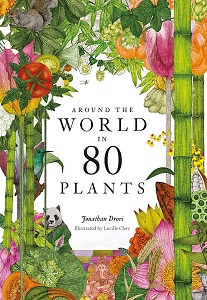
I imagined Jon Drori's world tour starring 80 plants would be interesting to a plant nerd like myself. Inspired by Jules Verne's Around the World in 80 Days, Drori's second book follows on the well-received Around the World in 80 Trees, but with more flowers and herbaceous subjects. I was not disappointed. The book is fun and informative with a perfect mix of botany, history and culture.
I was surprised to learn that the common Rhododendron native to Turkey, which is invading natural areas of Western Scotland, produces toxic nectar. The honeybees that evolved with this Rhododendron aren't harmed by the toxin. However, the "mad honey" created from this nectar causes low blood pressure and general feelings of wooziness in humans who eat it. Drori reports that the delicious but dangerous mad honey was used as a bioweapon against pursuing Roman soldiers in 69 BCE by a fleeing Persian army.
The country/plant associations are not always obvious nor necessarily plants native to the country or even the region. Scotland gets Rhododendron because it is so invasive that it is taking over the countryside there. One unusual tree representing the USA is the Cook Island pine, frequently planted in California, especially on college campuses. Part of the fun of this book is anticipating which plants represent which countries. Germany has entries on barley and hops, while Australia has the endemic grass tree (Xanthorrhoea), but also the opium poppy because it is the world's largest legal supplier to the pharmaceutical industry. Most of the included plants make an economic or cultural contribution to humankind, such as sugar cane, henna, wormwood or yerba mate. Others, such as sphagnum moss or saguaro cactus, anchor an ecosystem. A few plants are simply botanically remarkable, such as Welwitschia growing in the harsh Angolan desert. It survives by collecting moisture from fog, and Charles Darwin described it as the "platypus of the plant world" because it exhibits traits from both cone-bearing and flowering plants.
Drori's writing style is clear and engaging. He teases us with just enough botanic and cultural highlights, and seldom writes more than 2 pages of text per entry. I would guess that most of these 80 plants could each have their own book filled with history, lore and botany. French illustrator Lucille Clerc really brings the entries alive with captivating color drawings of plant habit and flowers, but also little sketches of products made from the plants, such as thread on spools and a bottle of linseed oil for the entry on flax. The illustrations for lotus were so expansive that they required a two-page spread without any text.